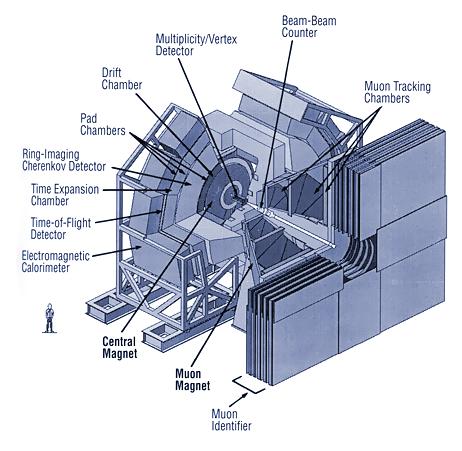




The PHENIX Detector
PHENIX, the Pioneering High Energy Nuclear Interaction eXperiment, was a detector designed to investigate high energy collisions of heavy ions and protons. The primary goal of PHENIX was to discover and study a new state of matter called the Quark-Gluon Plasma.
The PHENIX detector, now decommissioned, recorded many different particles emerging from RHIC collisions, including photons, electrons, muons, and quark-containing particles called hadrons.
A Massive Machine to Look 'Inside' a Collision
Photons (particles of light) and leptons (electrons and muons) are not affected by the strong force, which binds quarks and gluons together into hadrons. Because they can emerge unchanged from the interior of a RHIC collision, photons and leptons carry unmodified information about processes within the collision. A good analogy is that PHENIX was used to look "inside" the hot, dense matter formed in the collision, much like x-ray or MRI images show medical doctors the "inside" of the human body. For example, escaping photons can reveal information about the temperature of the collision.
PHENIX weighed 4,000 tons and had a dozen detector sub-systems. Three large steel magnets produced high magnetic fields to bend charged particles along curved paths. Tracking chambers recorded hits along the flight path to measure the curvature and thus determine each particle's momentum. Other detectors identified the particle type and/or measure the particle's energy. Still others recorded where the collision occurred and determined whether each collision was "head-on" (central), a "near-miss" (peripheral), or something in between.
New Explorations
RHIC’s discovery of the perfect liquid set off a decade-long and very successful effort to characterize its remarkable properties. Understanding exactly how the QGP’s perfect fluidity and other collective properties emerge from its point-like constituent particles remains a mystery. To address that mystery, a group of nuclear physicists has formed a new scientific collaboration that will expand on discoveries made by RHIC. A major upgrade to the PHENIX detector called sPHENIX will collect the necessary data.
Funding Agencies

Office of Nuclear Physics of U.S. Department of Energy's Office of Science
U.S. National Science Foundation
Ministry of Education, Culture, Sports, Science and Technology of Japan
Japan Society for the Promotion of Science
National Council for Scientific and Technological Development, Brazil
Research Supporting Foundation of the State of Sao Paulo, Brazil
National Natural Science Foundation of China
National Institute of Nuclear Physics and Particle Physics of the National Center for Scientific Research of France
Atomic Energy Commission of France
ARMINES (France)
Federal Ministry of Education and Research of Germany
German Academic Exchange Service
Alexander von Humboldt Foundation, Germany
National Scientific Research Foundation of Hungary
Department of Atomic Energy of India
Department of Science and Technology of India Israel Science Foundation
Korea Research Foundation
Center for High Energy Physics of Korea
Russian Ministry of Science and Technology
Russian Academy of Sciences
Russian Ministry of Atomic Energy
VR (Sweden)
Knut and Alice Wallenberg Foundation (Sweden)
U.S. Civilian Research and Development Foundation for the FSU
Hungarian Academy of Sciences (MTA)
Hungarian American Enterprise Scholarship Fund
Hungarian National Science Fund (OTKA)
US-Hungarian Fulbright Foundation
U.S.-Hungarian NSF-OTKA-MTA
U.S.-Israel Binational Science Foundation

